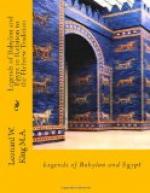(1) This argument is taken from an article I published in Professor Headlam’s Church Quarterly Review, Jan., 1916, pp. 280 ff., containing an account of Dr. Poebel’s discovery.
I should like to add, with regard to this reading of our new evidence, that I am very glad to know Sir James Frazer holds a very similar opinion. For, as you are doubtless all aware, Sir James is at present collecting Flood stories from all over the world, and is supplementing from a wider range the collections already made by Lenormant, Andree, Winternitz, and Gerland. When his work is complete it will be possible to conjecture with far greater confidence how particular traditions or groups of tradition arose, and to what extent transmission has taken place. Meanwhile, in his recent Huxley Memorial Lecture,(1) he has suggested a third possibility as to the way Deluge stories may have arisen.
(1) Sir J. G. Frazer,
Ancient Stories of a Great Flood
(the Huxley Memorial
Lecture, 1916), Roy. Anthrop. Inst.,
1916.
Stated briefly, it is that a Deluge story may arise as a popular explanation of some striking natural feature in a country, although to the scientific eye the feature in question is due to causes other than catastrophic flood. And he worked out the suggestion in the case of the Greek traditions of a great deluge, associated with the names of Deucalion and Dardanus. Deucalion’s deluge, in its later forms at any rate, is obviously coloured by Semitic tradition; but both Greek stories, in their origin, Sir James Frazer would trace to local conditions—the one suggested by the Gorge of Tempe in Thessaly, the other explaining the existence of the Bosphorus and Dardanelles. As he pointed out, they would be instances, not of genuine historical traditions, but of what Sir James Tyler calls “observation myths”. A third story of a great flood, regarded in Greek tradition as the earliest of the three, he would explain by an extraordinary inundation of the Copaic Lake in Boeotia, which to this day is liable to great fluctuations of level. His new theory applies only to the other two traditions. For in them no historical kernel is presupposed, though gradual erosion by water is not excluded as a cause of the surface features which may have suggested the myths.
This valuable theory thus opens up a third possibility for our analysis. It may also, of course, be used in combination, if in any particular instance we have reason to believe that transmission, in some vague form, may already have taken place. And it would with all deference suggest the possibility that, in view of other evidence, this may have occurred in the case of the Greek traditions. With regard to the theory itself we may confidently expect that further examples will be found in its illustration and support. Meanwhile in the new Sumerian Version I think we may conclude that we have recovered beyond any doubt the origin of the Babylonian and Hebrew traditions and of the large group of stories to which they in their turn have given rise.




